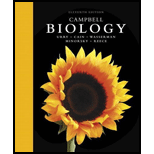
Campbell Biology (11th Edition)
11th Edition
ISBN: 9780134093413
Author: Lisa A. Urry, Michael L. Cain, Steven A. Wasserman, Peter V. Minorsky, Jane B. Reece
Publisher: PEARSON
expand_more
expand_more
format_list_bulleted
Question
Chapter 10.2, Problem 3CC
Summary Introduction
To determine: The rate of ATP synthesis in chloroplasts when a compound makes the membrane more permeable to hydrogen ions that are added.
Concept introduction: ATP synthase synthesizes ATP in chloroplast by the action of Chemiosmosis. “Chemiosmosis is the movement of ions across a semi permeable membrane”. In photosynthesis or
Expert Solution & Answer
Want to see the full answer?
Check out a sample textbook solution
Students have asked these similar questions
What is the structure and function of Eukaryotic cells, including their organelles? How are Eukaryotic cells different than Prokaryotic cells, in terms of evolution which form of the cell might have came first? How do Eukaryotic cells become malignant (cancerous)?
What are the roles of DNA and proteins inside of the cell? What are the building blocks or molecular components of the DNA and proteins? How are proteins produced within the cell? What connection is there between DNA, proteins, and the cell cycle? What is the relationship between DNA, proteins, and Cancer?
Why cells go through various types of cell division and how eukaryotic cells control cell growth through the cell cycle control system?
Chapter 10 Solutions
Campbell Biology (11th Edition)
Ch. 10.1 - Prob. 1CCCh. 10.1 - Explain how the use of an oxygen isotope helped...Ch. 10.1 - WHAT IF? The Calvin cycle requires ATP and NADPH,...Ch. 10.2 - What color of light is least effective in driving...Ch. 10.2 - In the light reactions, what is the initial...Ch. 10.2 - Prob. 3CCCh. 10.3 - To synthesize one glucose molecule, the Calvin...Ch. 10.3 - How are the large numbers of ATP and NADPH...Ch. 10.3 - Prob. 3CCCh. 10.3 - DRAW IT Redraw the cycle in Figure 10.19 using...
Ch. 10.3 - Prob. 5CCCh. 10.4 - Describe how photorespiration lowers...Ch. 10.4 - The presence of only PS I, not PS II, in the...Ch. 10.4 - MAKE CONNECTIONS Refer to the discussion of ocean...Ch. 10.4 - WHAT IF? How would you expect the relative...Ch. 10.5 - MAKE CONNECTIONS Can plants use the sugar they...Ch. 10 - Compare the roles of CO2 and H2O in cellular...Ch. 10 - The absorption spectrum of chlorophyll a differs...Ch. 10 - Prob. 10.3CRCh. 10 - Why are C4 and CAM photosynthesis more...Ch. 10 - Explain how all life depends on photosynthsis.Ch. 10 - The light reactions of photosynthesis supply the...Ch. 10 - Which of the following sequences correctly...Ch. 10 - How is photosynthesis similar in C4 plants and CAM...Ch. 10 - Prob. 4TYUCh. 10 - Prob. 5TYUCh. 10 - In mechanism, photophosphorylation is most similar...Ch. 10 - Prob. 7TYUCh. 10 - Prob. 8TYUCh. 10 - EVOLUTION CONNECTION Photorespiration can decrease...Ch. 10 - SCIENTIFIC INQUIRY MAKE CONNECTIONS The following...Ch. 10 - WRITE ABOUT A THEME: ENERGY AND MATTER Life is...Ch. 10 - SYNTHESIZE YOUR KNOWLEDGE Watennelon snow in...
Knowledge Booster
Similar questions
- In one paragraph show how atoms and they're structure are related to the structure of dna and proteins. Talk about what atoms are. what they're made of, why chemical bonding is important to DNA?arrow_forwardWhat are the structure and properties of atoms and chemical bonds (especially how they relate to DNA and proteins).arrow_forwardThe Sentinel Cell: Nature’s Answer to Cancer?arrow_forward
- Molecular Biology Question You are working to characterize a novel protein in mice. Analysis shows that high levels of the primary transcript that codes for this protein are found in tissue from the brain, muscle, liver, and pancreas. However, an antibody that recognizes the C-terminal portion of the protein indicates that the protein is present in brain, muscle, and liver, but not in the pancreas. What is the most likely explanation for this result?arrow_forwardMolecular Biology Explain/discuss how “slow stop” and “quick/fast stop” mutants wereused to identify different protein involved in DNA replication in E. coli.arrow_forwardMolecular Biology Question A gene that codes for a protein was removed from a eukaryotic cell and inserted into a prokaryotic cell. Although the gene was successfully transcribed and translated, it produced a different protein than it produced in the eukaryotic cell. What is the most likely explanation?arrow_forward
- Molecular Biology LIST three characteristics of origins of replicationarrow_forwardMolecular Biology Question Please help. Thank you For E coli DNA polymerase III, give the structure and function of the b-clamp sub-complex. Describe how the structure of this sub-complex is important for it’s function.arrow_forwardMolecular Biology LIST three characteristics of DNA Polymerasesarrow_forward
arrow_back_ios
SEE MORE QUESTIONS
arrow_forward_ios
Recommended textbooks for you
 Biology (MindTap Course List)BiologyISBN:9781337392938Author:Eldra Solomon, Charles Martin, Diana W. Martin, Linda R. BergPublisher:Cengage Learning
Biology (MindTap Course List)BiologyISBN:9781337392938Author:Eldra Solomon, Charles Martin, Diana W. Martin, Linda R. BergPublisher:Cengage Learning BiochemistryBiochemistryISBN:9781305577206Author:Reginald H. Garrett, Charles M. GrishamPublisher:Cengage Learning
BiochemistryBiochemistryISBN:9781305577206Author:Reginald H. Garrett, Charles M. GrishamPublisher:Cengage Learning Biology: The Dynamic Science (MindTap Course List)BiologyISBN:9781305389892Author:Peter J. Russell, Paul E. Hertz, Beverly McMillanPublisher:Cengage Learning
Biology: The Dynamic Science (MindTap Course List)BiologyISBN:9781305389892Author:Peter J. Russell, Paul E. Hertz, Beverly McMillanPublisher:Cengage Learning Biology 2eBiologyISBN:9781947172517Author:Matthew Douglas, Jung Choi, Mary Ann ClarkPublisher:OpenStax
Biology 2eBiologyISBN:9781947172517Author:Matthew Douglas, Jung Choi, Mary Ann ClarkPublisher:OpenStax Biology: The Unity and Diversity of Life (MindTap...BiologyISBN:9781305073951Author:Cecie Starr, Ralph Taggart, Christine Evers, Lisa StarrPublisher:Cengage Learning
Biology: The Unity and Diversity of Life (MindTap...BiologyISBN:9781305073951Author:Cecie Starr, Ralph Taggart, Christine Evers, Lisa StarrPublisher:Cengage Learning Human Physiology: From Cells to Systems (MindTap ...BiologyISBN:9781285866932Author:Lauralee SherwoodPublisher:Cengage Learning
Human Physiology: From Cells to Systems (MindTap ...BiologyISBN:9781285866932Author:Lauralee SherwoodPublisher:Cengage Learning

Biology (MindTap Course List)
Biology
ISBN:9781337392938
Author:Eldra Solomon, Charles Martin, Diana W. Martin, Linda R. Berg
Publisher:Cengage Learning

Biochemistry
Biochemistry
ISBN:9781305577206
Author:Reginald H. Garrett, Charles M. Grisham
Publisher:Cengage Learning

Biology: The Dynamic Science (MindTap Course List)
Biology
ISBN:9781305389892
Author:Peter J. Russell, Paul E. Hertz, Beverly McMillan
Publisher:Cengage Learning

Biology 2e
Biology
ISBN:9781947172517
Author:Matthew Douglas, Jung Choi, Mary Ann Clark
Publisher:OpenStax

Biology: The Unity and Diversity of Life (MindTap...
Biology
ISBN:9781305073951
Author:Cecie Starr, Ralph Taggart, Christine Evers, Lisa Starr
Publisher:Cengage Learning

Human Physiology: From Cells to Systems (MindTap ...
Biology
ISBN:9781285866932
Author:Lauralee Sherwood
Publisher:Cengage Learning